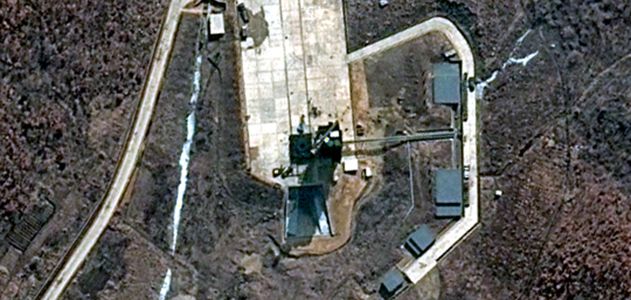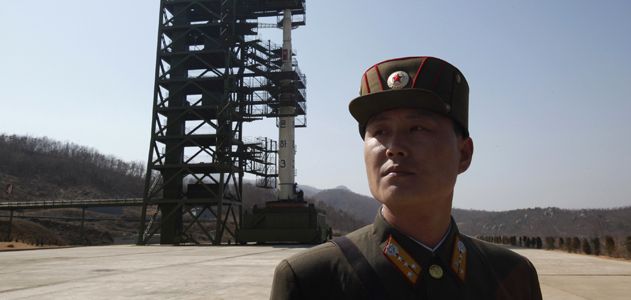How did North Korea build its own rocket?
The origin of Unha-3.
/https://tf-cmsv2-smithsonianmag-media.s3.amazonaws.com/filer/RTR30HU1-631.jpg)
That an impoverished nation like North Korea could develop—and then attempt to launch—its own long-range rocket and satellite payload got us wondering about the origins of the three-stage Unha-3 (“Galaxy-3”) booster.
Western analysts believe the Unha-3 is a hybrid of Soviet and Iranian design, derived from the Taepodong-2 missile that North Korea began developing in the 1990s, but which has never successfully launched.
China—North Korea’s closest ally—appears not to have had a hand in the rocket’s development, says David Wright, senior scientist and co-director of global security at the Union of Concerned Scientists. “We’re not seeing tell-tale signs that there’s any linkage.”
No one in the West knows how much of the latest rocket and its engines were actually built inside North Korea. “It’s not clear what North Korea got from the Soviets,” says Wright. “One speculation is they may have gotten some [rocket] production equipment and machine tools…We don’t know if they’re self-sufficient” when it comes to booster technology.
North Korea has been rolling out ballistic missiles since the 1970s, when it first got Soviet Scud-B launchers from Egypt in return for help in the 1973 Arab-Israeli war. The first North Korean-built missiles—essentially Scud copies—were developed in the 1980s and were called the Hwasong-5 and the Hwasong-6.
By 1990, North Korea had produced an upgraded version called the Nodong, which had a longer range and greater payload capacity. (It was the Nodong that alarmed the West on July 4, 2009, when North Korea fired off seven of them from its east coast.) Next came the two-stage Taepodong-1 rocket (using a Hwasong atop a Nodong), which could deliver a one-ton payload up to 1,500 miles.
In August 1998, in North Korea’s first orbital attempt, a Taeopodong-1 with an additional third stage lifted off with a small satellite called Kwangmhyongsong-1 (“Bright Star 1”). The launch failed when the third stage didn’t ignite. North Korea then began working on a successor missile, called Taepodong-2, which launched only once, in July 2006; the missile blew up 40 seconds after launch. (An additional missile, called Taepodong-X, has not been tested, and little is known about it.)
The 91-ton, 100-foot-tall Unha-3 is a slightly modified version of the Unha-2 that North Korea launched eastward in 2009, a liftoff condemned by the United Nations Security Council, which considered it a ballistic missile test and soon thereafter tightened economic sanctions on the country. That orbital attempt—North Korea’s second—also ended in failure when the rocket’s third stage failed to ignite and fell into the Pacific Ocean.
The Unha-3’s first stage, about eight feet in diameter, appears to be made of steel and weighs about 60 tons, says Wright. “We’re pretty sure the first-stage engine is a Soviet design,” a scaled up version of the engine used in the Scud-B design, he says. It burns kerosene and nitric acid. The first stage has four such engines that share a common fuel tank.
The slimmer second stage is “a much more advanced design,” Wright says, that is identical to the submarine-launched Soviet R-27 ballistic missile, called the SS-N-6 in the United States. That stage has three engines: a main one for propulsion and two smaller ones for steering. “It’s not clear to me that they know how to build that engine,” says Wright. It burns a toxic, volatile, clear liquid fuel known as UDMH (unsymmetrical dimethylhydrazine) and nitrogen tetroxide. The Soviets first deployed he SS-N-6 in 1968. North Korea got some in the 1990s and modified them for use as intermediate-range missiles.
The third stage appears to be identical to the upper stage of the Iranian Safir-2 booster, which Iran used to put a small satellite into orbit in February 2009. The Safir-2 uses the small steering motors from the SS-N-6 for propulsion, Wright says.
“There is strong evidence that Pyongyang’s missile development program depended heavily on technology and assistance from Russian missile experts, although possibly without the involvement of the Russian government,” Wright wrote in a March 2009 analysis in the Bulletin of Atomic Scientists before launch of the Unha-2.
For that launch, North Korea for the first time announced splashdown zones for the first two stages and issued notices of the expected trajectory—something Pyongyang has also done for the Unha-3. It also invited the international press to view the booster, control room, and the 220-pound Kwangmyong-3 satellite designed to return data and images from orbit. The mission is part of the mid-April celebrations to make the 100th anniversary of the birth of North Korean founder Kim Il Sung.
“I think the bigger goal here is to reinforce the powers of the regime and to remind the world that they’re here,” says Brian Weeden, technical advisor at the Secure World Foundation and a former satellite tracking officer at U.S. Space Command. “We don’t expect them to invite in the international press for every launch.”
Unlike on previous orbital attempts, the North Korean state media reported—after a four-hour silence--that the Unha-3 did not reach orbit. Which may not matter to the North Korean people, who’ve been told their country already has two satellites in space.

